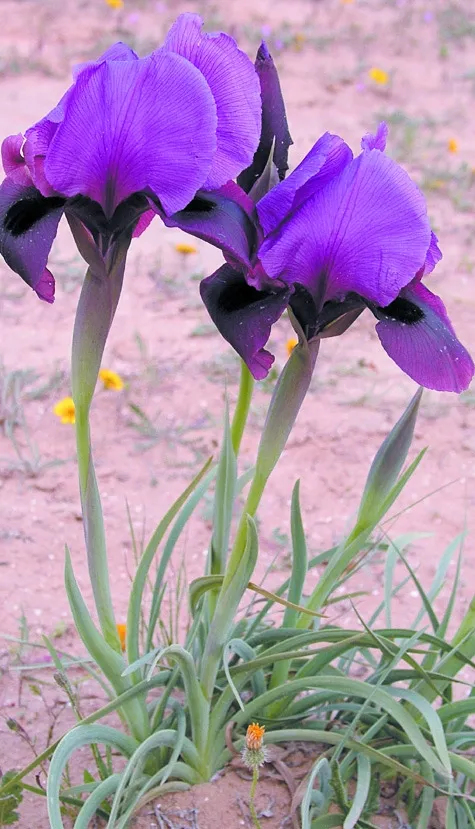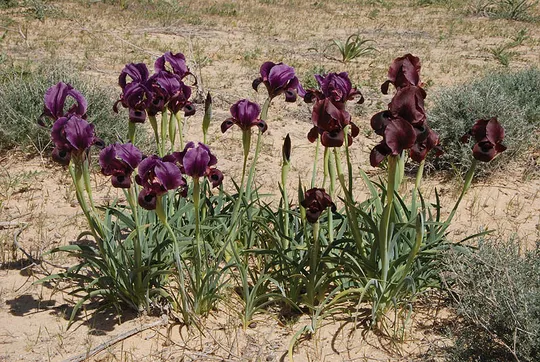Mary's Iris, Helena's Iris
Iris mariae



Iris mariae is a geophyte in the Iris section Oncocyclus. Its falcate leaves are very narrow – 5-13 mm wide. The flowering stem is 20-40 cm tall and the violet flower's diameter is 5-7 cm. The leaves emerge after the rain, and the flower opens in late February to early March.
The species grows in Israel only in the western Negev region in the
large sand triangle called “Halutsa Sands”: from Kibbutz Magen and Nir Yitshak in
the north down to Nitsana and Shdemot Shezaf (Be’erotayim) in the south and
west to the Sekher Sands (Ramat Hovav). The populations are dense and grow on
Mount Keren, in the Agur Sands, south of Tse’elim and near Gvulot.
Desert sands, sandy loess plains with a precipitation of 80-150 mm.
This is the only royal iris species that grows in the extreme desert,
where annual precipitation is 150 mm or less. This is also the southernmost of
all of the royal iris species, except for Iris petrana in Edom.
Species similar to Iris mariae grow in southeastern Turkey and
northwestern Iran (Avishai 1980). Sapir et al. (2002) found that farther south
along the geographic gradient the leaves of the Iris species become
smaller and narrower, and their shape becomes scythe-like. Indeed, the most
extreme expression of this trend can be seen in Iris mariae: its leaves
are very arched and even curly; the leaves are short and only one centimeter
across.
According to a few researchers, the dark royal irises in Israel are
actually one broad species, which can be divided into subspecies or geographic
ecotypes. Even according to this view, Iris mariae has an independent status
due to its unmistakable difference from the other dark species. Its flower is
smaller, the leaves more arched and the hairs inside the pollen tube are black
or purple – as opposed to the yellow hairs of the other dark species. Unlike
the other royal irises, Iris mariae exhibits morphological similarity between
specimens within populations and between them as well. This fact suggests that
the species originated from a very small number of individuals, and that a barrier
exists that prevented gene exchange between Iris mariae and closely
related species.
·
The species is unique to
sand and stabilized sand, and does not stray from this habitat. This habitat is
threatened by the agricultural and residential development plans for the Halutsa
Sands. Iris mariae is sensitive to rodents that feed on its rhizomes and
to intensive grazing. The species was collected for export as far back as 1892,
when large amounts were amassed following the “iris craze” in Europe. Today,
there is no supervision over the Sinai populations, and future development plans
and deliberate uprooting by Bedouins pose a severe threat to the western Negev
populations.
·
Vegetative reproduction
creates dense, local patches. The locations in the Negev are fragmented and
only a few kilometers apart.
·
There is no substantiated knowledge
about the Sinai populations across the border. Most of the Sinai populations
are almost certainly endangered or extinct due to overgrazing (iris leaves are consumed
when there are no other leaves available).
·
Iris mariae is protected in the Bir-Mashash Sands
Reserve, Shunra Sands Reserve and the Agur Sands Reserve.
The species should be
totally protected from picking and uprooting. Populations within reserves should
be tracked and monitored.
The plant is endemic to Israel and Sinai (described from Wadi El-Arish
in northwestern Sinai). The primary populations are concentrated in Halutsa
Sands in Israel, with a few populations located in the sands west of the border
highway down to Wadi El-Arish.
This is the driest
species in the entire royal iris section (section Oncocyclus). It is characteristic
of desert sands and endemic to Israel and Sinai. In Israel, its distribution is
limited to the Halutza and Wadi Sekher Sands area. Due to the sensitivity of
the habitat to agricultural development and SUVs, preservation efforts should
be focused on large Iris mariae concentrations.
Current Occupancy Map
| 1000 squre meter pixel | 5000 squre meter pixel | 10000 squre meter pixel | |
|---|---|---|---|
| number of observations | 0 | 0 | 0 |
| in total pixels | 0 | 0 | 0 |
| Family | Iridaceae |
| Classification | Unlisted |
| Ecosystem | Desert |
| Chorotype | Endemic – Saharo-Arabian |
| Conservation Site | Shunra Sands Reserve |
| Rarity |
1
1
6
|
|---|---|
| Vulnerability |
0
1
4
|
| Attractiveness |
0
3
4
|
| Endemism |
0
4
4
|
| Red number |
1
4.2
10
|
| Peripherality | 0 |
| IUCN category | DD EW EX LC CR EN VU NT |
| Threat Definition according to the red book | Endangered |
 Based on:
Based on:






